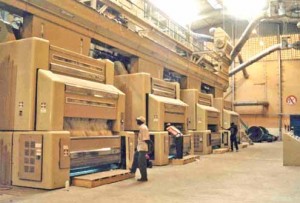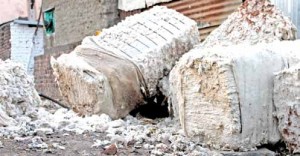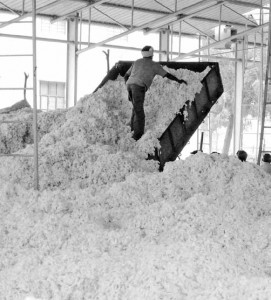Indian ginneries are being classified into five different quality groups with grades ranging from “Single Star” to “5-Star” by means of an objective assessment methodology available with the Textiles Committee. Here is an attempt to introduce cotton traders and spinning mills to the concept of Star Rating of ginneries based on the quality of machinery, civil infrastructure and work practices. For the cotton trader, Star Rating will serve as the basis for selecting ginneries to realize the desired level of cotton quality. Spinning mills can make best use of information on Star Rating by indicating their preference for the Star status of the ginnery in which they would like their cotton to be processed.
Ginneries in India have undergone a qualitative transformation through the Technology Mission on Cotton (TMC), a subsidy scheme launched by the Government in February 2000. About 850 ginning and pressing units were either modernized or newly set up under TMC during its 11-year tenure till 2010. Even after TMC came to an end, many units have been modernized or newly set up through the Technology Upgradation Fund Scheme (TUFS), or without any financial support from the Government.
Need for star rating
 Although over 1,000 G&P factories in India are referred to as modernized, there are wide differences among them in the quality and level of modernization.
Although over 1,000 G&P factories in India are referred to as modernized, there are wide differences among them in the quality and level of modernization.
While some units chose to meet just the minimum requirements prescribed by TMC or TUFS, others went on a modernization overdrive, incorporating machines and civil structures far above the suggested norms in terms of quality, number and dimensions.
As a result, ginneries in India today present a wide range of infrastructural quality. It became necessary to evolve a methodology by which the modernized ginneries could be classified into different quality groups. The Star Rating scheme initially developed for TMC units was entrusted by the Government to the Textiles Committee for countrywide application.
Under this voluntary scheme, each factory seeking Star Rating is inspected by a team of experts from the Textiles Committee for an assessment of its infrastructure. During assessment, as many as 21 infrastructural components, including machinery and civil structures, are assigned marks based on their technical merit. Each component is assigned a weightage representing the extent of its influence on cotton quality, and the weighted marks are arrived at for each infrastructural component. Similarly weighted marks are calculated for 13 management parameters, including the contamination level in the bale. On the basis of marks and certain other criteria, appropriate Star Rating is arrived at.
Star Rating awarded to a ginnery is valid for a period of three years. During the validity period, there would be annual assessment based on surveillance inspection. After three years, reassessment will be done and fresh rating awarded.
Status of assessment
 The Star Rating scheme was launched by the Textiles Committee in January 2009. There has been overwhelming response from ginneries. Within a span of three years, as many as 772 G&P units had applied for assessment despite the scheme being purely voluntary. T
The Star Rating scheme was launched by the Textiles Committee in January 2009. There has been overwhelming response from ginneries. Within a span of three years, as many as 772 G&P units had applied for assessment despite the scheme being purely voluntary. T
he accompanying table gives the number of G&P units in each Star category and provisionally rated out of the 698 units whose assessment was completed till March 2012.
As mentioned already, Star Rating is awarded to a ginnery on the basis of the quality of machinery and civil structures as well as the management style. Technical merit of cotton cleaning machines (pre-cleaner and lint cleaner), the extent of automation in transfer of materials (seed-cotton, lint and seeds), the technology level of conveyors (belt/pneumatic/screw/trolleys), the type of baling press (manual/automatic/semi-automatic), the moisturizing facility for cotton (kapas & lint), etc., will greatly affect the fiber quality (length, short fibre content, seed-coat fragments, neps, etc.) as well as the level of contamination (trash & foreign matter). Technical features and dimensions of civil structures such as storage spaces provided for, kapas, lint and pressed bales are also critical factors shaping cotton quality. Equally important is the manner in which recommended management practices are followed at the ginnery. All these features will be reflected in the Star Rating accorded to a ginnery.
In short, Star Rating could be seen as the hallmark of a ginnery’s technical excellence and as an indicator of the potential of the ginning unit to turn out quality cotton bales.
Relevance to spinners
 Textile mills purchasing Indian cotton will greatly benefit from the information on Star Rating. Superior Star Rating will promise better quality from the points of view of purity or cleanness as well as of superior fibre attributes. This is so because factories with high star ratings are of superior infrastructural quality and have the capacity to turn out bales of excellent quality.
Textile mills purchasing Indian cotton will greatly benefit from the information on Star Rating. Superior Star Rating will promise better quality from the points of view of purity or cleanness as well as of superior fibre attributes. This is so because factories with high star ratings are of superior infrastructural quality and have the capacity to turn out bales of excellent quality.
The following facts are worth noting in this context:
• Modern ginning machines will deliver lint with minimal fibre cut, short fibre content, seed coat fragments and cut seeds.
• A good pre-cleaner will reduce trash and remove contaminants that do not cling to the fibres
• A good lint cleaner will ensure the removal of residual trash from ginned lint and elimination of short fibres, besides removing dust adhering to fibres.
• Pneumatic seed-cotton conveyor from heaps to pre-cleaner, besides guaranteeing contamination-free transfer of cotton, serves to remove stones and other heavy objects from kapas.
• Automatic seed-cotton conveyor inside the gin hall, fitted with sensor-controlled droppers, will regulate the ginning process and ensure constant ginning speed.
• High quality pneumatic lint conveyor will remove short fibres besides ensuring contamination-free transfer of lint from gins to pala hall or bale press.
• Modern automatic bale press will serve to deliver contamination-free bales of constant weight.
• Moisturizes of appropriate quality for kapas will reduce fibre breaks, bring down short fibre content and increase fibre length.
• Moisturizers for lint will ensure constant bale weight and easy compaction during pressing.
• Large, good quality storage spaces for kapas, lint, seed and pressed bales will serve to avert contamination of cotton.
• Good management practices, including deployment of trained gin fitters and contamination pickers at appropriate locations in the ginnery, will respectively ensure minimal loss of fibre length and delivery of contamination-free cotton bales.
The above list highlights the influence of some of the infrastructural components of a ginnery on the quality of cotton bales processed in it. The extent of impact on cotton quality will depend on the degree of sophistication of each component. A factory with more sophisticated infrastructural components will score more marks and will be placed in a higher star category.
Spinning mills scouting for good quality cotton should understand the impact of various machines, civil structural facilities and the management style of a ginnery while deciding on cotton purchase. A ginnery with a high Star status ought to be the choice for a discerning spinning mill intending to purchase high quality cotton.